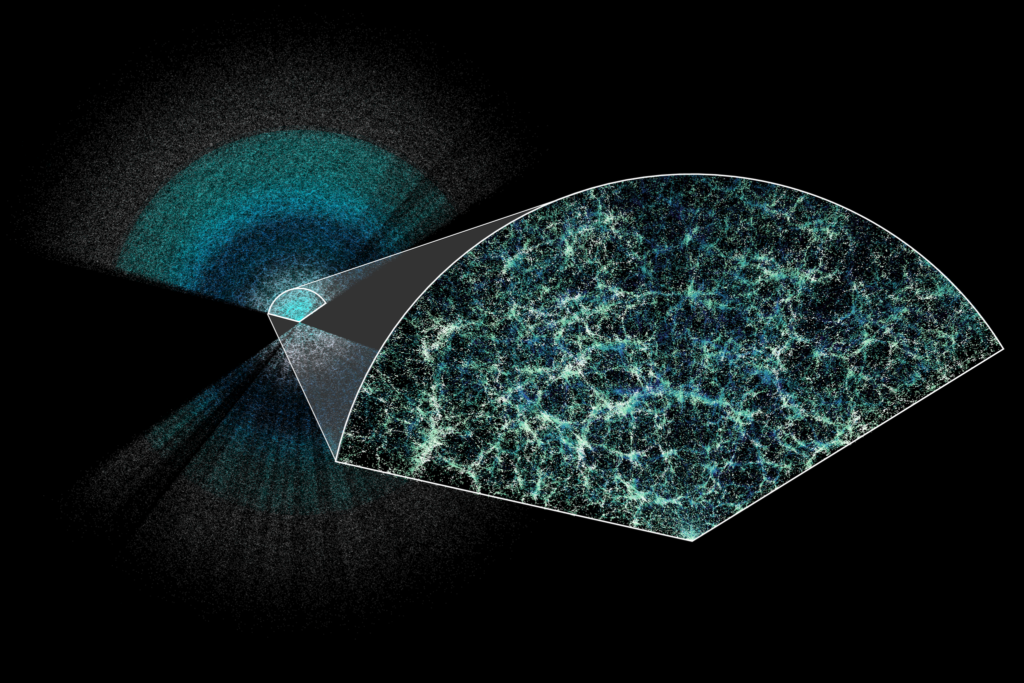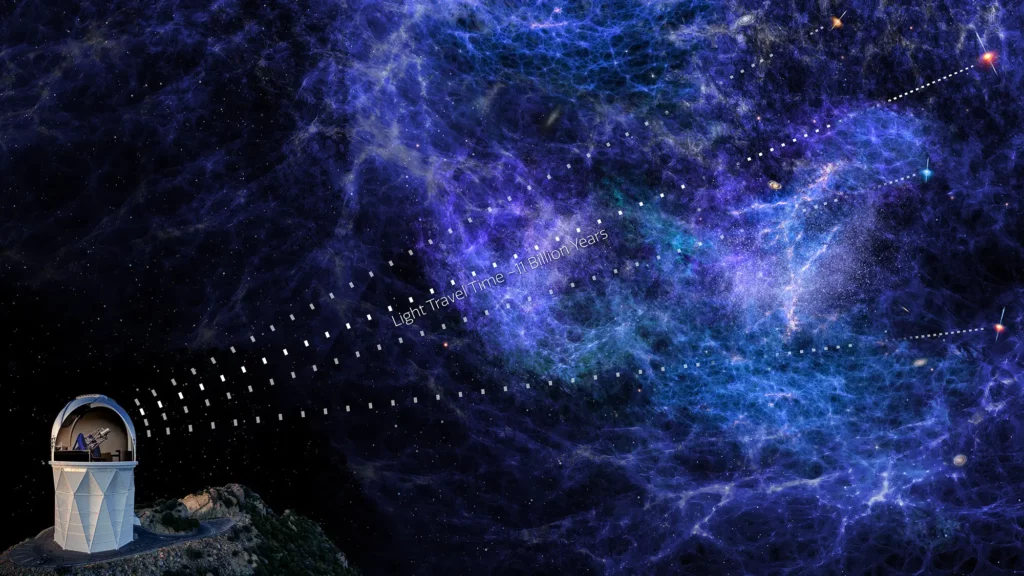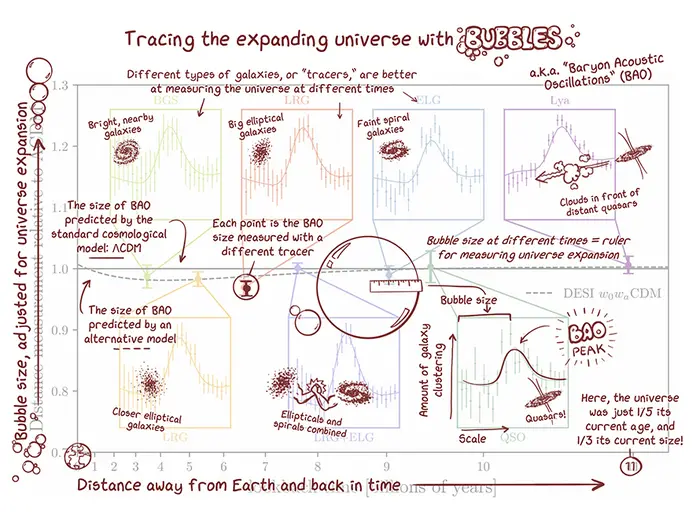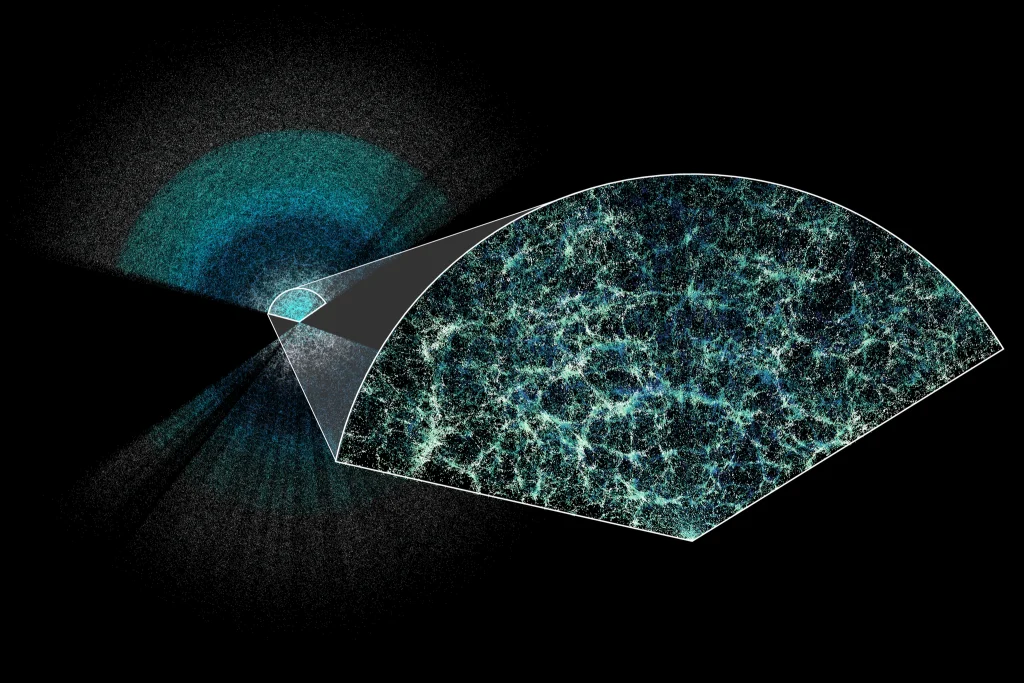
The Dark Energy Spectroscopic Instrument (DESI) has revolutionized our understanding of the cosmos by providing the most precise measurement ever of the universe’s expansion. Situated on a mountain in Arizona, DESI uses 5,000 tiny robots in a telescope to capture light from galaxies up to 11 billion light-years away. Scientists can now observe the universe in its early years and track its evolution to today.
At the core of this accomplishment is the study of the effects of dark energy, the elusive force that causes the universe to expand at an increasing rate. DESI's data was used to create the largest and most precise 3D map of the universe, measuring the expansion history of the early universe with an error of less than 1%.
Measuring the early universe is an incredible challenge. Yet, in just one year, DESI has doubled its effectiveness in tracking the expansion history of these early times compared to its predecessor, the Sloan Digital Sky Survey’s BOSS/eBOSS, which took over a decade to achieve similar results.
“We’re incredibly proud of the data, which have produced world-leading cosmology results and are the first to come out of the new generation of dark energy experiments,” said Michael Levi, DESI director and a scientist at the Department of Energy’s Lawrence Berkeley National Laboratory (Berkeley Lab), which manages the project.
“So far, we’re seeing basic agreement with our best model of the universe, but we’re also seeing some potentially interesting differences that could indicate that dark energy is evolving with time. Those may or may not go away with more data, so we’re excited to start analyzing our three-year dataset soon.”
Mapping the Cosmic Web
This mapping effort is not only a technological achievement but also a collaborative triumph, involving over 900 researchers from more than 70 institutions worldwide. The instrument is located at the Nicholas U. Mayall 4-meter Telescope at Kitt Peak National Observatory, an important site for the Tohono O’odham Nation, a Native American people.
One intriguing outcome of DESI’s observations is the potential challenge it presents to the Lambda Cold Dark Matter (Lambda CDM) model. This model includes cold dark matter (CDM) and dark energy (Lambda). These have opposing effects on the universe’s expansion: while matter and dark matter slow it down, dark energy speeds it up, and the ratio of each determines the universe's evolution.
However, when astronomers combined the first-year results from DESI with data from other studies, they noticed some small discrepancies with Lambda CDM’s predictions, suggesting the need to revise our understanding of the universe’s composition and expansion.
The data indicates that dark energy, the force driving the accelerated expansion of the universe, might change over time. This concept could transform our understanding of cosmological theories.
As DESI continues its five-year survey and gathers more data, scientists will be more prepared to understand these initial findings. More data will also improve DESI’s preliminary findings on the Hubble constant, which measures the current expansion rate of the universe, and the mass of neutrinos.
DESI and the early universe
“We are delighted to see cosmology results from DESI’s first year of operations,” said Gina Rameika, associate director for High Energy Physics at the Department of Energy. “DESI continues to amaze us with its stellar performance and is already shaping our understanding of the universe.”

DESI, which has taken 14 years to develop, depends on a very advanced telescope at Kitt Peak that has over 5,000 fiber-optic detectors. These tools enable the telescope to monitor and perform spectroscopy on millions of galaxies at the same time. Essentially, astronomers measure how quickly these galaxies are moving away from Earth and then use this data to go back in time to “T zero,” when it all began.
This map shows the early condition of the universe. At that time, it was densely filled with tiny particles that would later form hydrogen and helium atoms. As the universe expanded and cooled, these particles arranged themselves into a pattern of ripples and clusters, setting the stage for the creation of galaxies.
Tiny changes in the early ionized gas plasma started pressure waves, propelling baryons into a ripple pattern similar to what happens when you throw a handful of gravel into a pond. As the universe expanded and cooled, neutral atoms formed, stopping the pressure waves and freezing the ripples in three dimensions. This process led to the increased clustering of future galaxies in denser areas. Billions of years later, this faint pattern of 3D ripples, or bubbles, still marks the characteristic separation of galaxies, a phenomenon known as Baryon Acoustic Oscillations (BAOs).
Mapping the speed of millions of galaxies
Researchers use BAO measurements as a cosmic ruler. By evaluating the apparent size of these bubbles, they can calculate distances to the matter that created this extremely faint pattern in the sky. Mapping BAO bubbles, both near and far, allows researchers to segment the data. This helps them determine the universe’s expansion rate at different points in its history and also how dark energy affects this expansion.

Measuring the expansion history and gaining a better understanding of dark energy through galaxies is one approach, but its reach has limits. Beyond a certain distance, light from typical galaxies becomes too faint, leading researchers to focus on quasars.
Quasars are extremely distant and bright galactic cores containing black holes at their centers. As light from these quasars travels through intergalactic clouds of gas, it gets absorbed, allowing researchers to map the dense matter pockets. They apply this information similarly to how they use galaxies, using a technique called the “Lyman-alpha forest.”
“We use quasars as a backlight to basically see the shadow of the intervening gas between the quasars and us,” said Andreu Font-Ribera, a scientist at the Institute for High Energy Physics (IFAE) in Spain who co-leads DESI’s Lyman-alpha forest analysis. “It lets us look out further to when the universe was very young. It’s a really hard measurement to do, and very cool to see it succeed.”
The great time of space science
The scientists used the biggest set of data ever gathered for Lyman-alpha forest measurements, which included 450,000 quasars, to expand their BAO measurements up to 11 billion years ago. DESI aims to map 3 million quasars and 37 million galaxies by the end of the survey.
After gathering their data, researchers found that the typical assumption of constant dark energy did not accurately describe the universe's expansion. Galaxies from the three most recent time periods seemed closer than expected, suggesting that dark energy might be changing with time.
“We are in the golden era of cosmology, with large-scale surveys ongoing and about to be started, and new techniques being developed to make the best use of these datasets,” said Arnaud de Mattia, a researcher with the French Alternative Energies and Atomic Energy Commission (CEA) and co-leader of DESI’s group interpreting the cosmological data. “We’re all really motivated to see whether new data will confirm the features we saw in our first-year sample and build a better understanding of the dynamics of our universe.”
The discoveries were published in several papers that were released today.
Was this useful?
Related Articles
- Scientists have managed to regrow limbs on frogs and hope to do the same for humans
- China is battling censorship by exporting the “Great Firewall”
- Researchers have spotted space debris in daylight, helping satellites ‘social distance’
- Blue light from smartphones and computer screens may speed up aging









